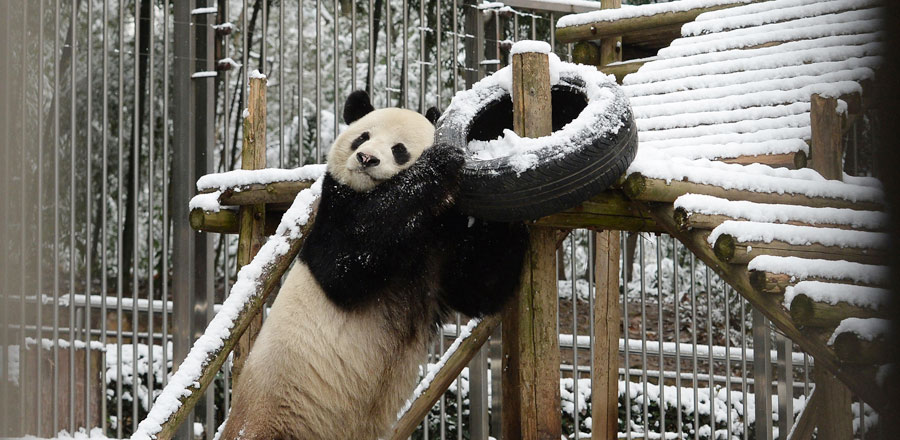Foothold strengthened at Earth's poles
Updated: 2016-01-25 07:47
By Zhao Xinying(China Daily)
|
|||||||||
|
Two researchers from the Chinese Antarctic Center of Surveying and Mapping conduct a leveling survey near China's Zhongshan Station in Antarctica. Provided to China Daily |
Surveying, mapping play key role as foundation for further research in extreme environment
An ordinary person might want to go to Antarctica to experience extreme cold, witness the midnight sun or get close to quirky penguins.
But something else is more important, though may not seem sexy. That's surveying and mapping the vast frozen continent.
It is actually a critical job for researchers.

"Surveying and mapping comes first for research in polar regions, both south and north," said Li Fei, director of the Chinese Antarctic Center of Surveying and Mapping at Wuhan University in Hubei province.
The center is one of the leading Chinese institutions on surveying and mapping in polar regions.
Li, who is also a vice-president of the university, visited the South Pole once and the North Pole twice. The experience may be rare for leaders of Chinese universities, but it's quite ordinary for researchers at the center, Li said.
Founded in 1991, the center has sent more than 100 people to participate in China's polar research efforts - 32 in Antarctica and 12 in the Arctic region.
Wang Zemin, deputy director of the center, has taken part in polar research expeditions eight times - four for each pole.
"As surveying and mapping staff, we are there mainly for two tasks," Wang said.
"One is to measure geographic positions and draw maps, which is the foundation for all further scientific research. The other is to observe and get to know more about the polar regions, in order to monitor environmental or climate changes across the globe."
People often say that global warming will lead to the melting of snow and ice in polar regions, which will result in a rising sea level and make an already bad global environment even worse, Wang said.
"But we don't totally buy such causes and consequences, because although the snow and ice of some places is melting, in other places it is accumulating."
The current research focus of the center is to figure out whether there are any cause-effect relationships in various phenomena, said Li, the director. "This is a major research angle for us in the following five years."
It is well known that polar researchers are likely to encounter multiple difficulties and dangers in their work.
Apart from the lonely life and the not-so-tasty food, researchers may also face such risks as falling into crevasses or being blown away by the strong polar wind. Their lives can be at risk, Wang said.
Yang Yuande, 34, an associate professor at the center, nearly died after falling into an ice crack when he was working in Antarctica in late 2012. Fortunately, he said, he was able to grab the edge of the crack and climb out with the help of colleagues, keeping China's death record at zero for polar region research.
But the difficulties and dangers have not stopped more members of the center, male and female, from heading to the poles.
Zhou Chunxia, 39, was the first female member the center sent to Antarctica. In late 2000, when she was a doctoral student at the center, she stepped onto the South Pole and spent a summer in the region.
"It wasn't that scary for me to work in Antarctica because I spent most of my time working at the Changcheng Station," Zhou said, referring to what has been dubbed the Great Wall Station, China's first research station in Antarctica. "But that doesn't mean working there is easy or relaxing. You have to work hard, and you also have lots of obstacles to overcome - like homesickness."
Zhou is now a professor of remote sensing technology and applications at the center.
The good news is that research conditions in the polar regions have improved greatly in recent years and have met many of the researchers' diverse needs, said deputy director Wang, adding that a good example is the improvement of the communication system.
"In the past, our polar researchers could contact their families only using a maritime satellite phone, which costs several dollars a minute," Wang said.
"Now the Internet is accessible there, allowing researchers to keep in touch with their families and friends through QQ, an instant messaging service - although the speed is not very good," he said.
The use of fixed-wing aircraft has also added convenience to surveying and research in polar regions, said Zhang Shengkai, an associate professor at the center who took part in China's measurements of Dome A, the highest ice feature of Antarctica at more than 4,000 meters above sea level, in 2004 and 2005.
Zhang said previous polar region research used helicopters, which could carry only a dozen people and fly a few hundred kilometers.
"Now fixed-wing aircraft can carry more people and equipment and fly longer distances. Such aircraft can be used to take aerial photos and to conduct a series of measurements and surveys, which will definitely improve China's ability in polar region research," Zhang said.
Recently, China's research team was reported to have achieved three breakthroughs in Antarctic research.
"We are all looking forward to generating more high-level scientific achievements," Zhang said.
zhaoxinying@chinadaily.com.cn
- A glimpse of Spring Rush: little migrant birds on the way home
- Policy puts focus on genuine artistic students
- Police unravel market where babies are bought, sold as commodities
- More older pregnant women expected
- Netizen backlash 'ugly' Spring Festival Gala mascot
- China builds Mongolian language corpus
- 2 Chinese nationals killed, 1 injured in suspected bomb attack in Laos
- New York, Washington clean up after fatal blizzard
- 'Plane wreckage' found in Thailand fuels talk of missing Malaysian jet
- Washington shuts down govt, NY rebounds after blizzard
- 7 policemen, 3 civilians killed in Egypt's Giza blast
- Former US Marine held in Iran arrives home after swap

 First trains of Spring Festival travel depart around China
First trains of Spring Festival travel depart around China
 Dough figurines of Monkey King welcome the New Year
Dough figurines of Monkey King welcome the New Year
 Ning Zetao, Liu Hong named China's athletes of the year
Ning Zetao, Liu Hong named China's athletes of the year
 Top 10 smartphone vendors based on market share in 2015
Top 10 smartphone vendors based on market share in 2015
 Snow scenery across China
Snow scenery across China
 Storm grips New York after dumping 2 feet of snow on Washington
Storm grips New York after dumping 2 feet of snow on Washington
 Art exhibitions in 2016 worth seeing
Art exhibitions in 2016 worth seeing
 Winter flexes its muscles as cold snap makes its way
Winter flexes its muscles as cold snap makes its way
Most Viewed
Editor's Picks

|

|

|

|

|

|
Today's Top News
National Art Museum showing 400 puppets in new exhibition
Finest Chinese porcelains expected to fetch over $28 million
Monkey portraits by Chinese ink painting masters
Beijing's movie fans in for new experience
Obama to deliver final State of the Union speech
Shooting rampage at US social services agency leaves 14 dead
Chinese bargain hunters are changing the retail game
Chinese president arrives in Turkey for G20 summit
US Weekly

|

|









